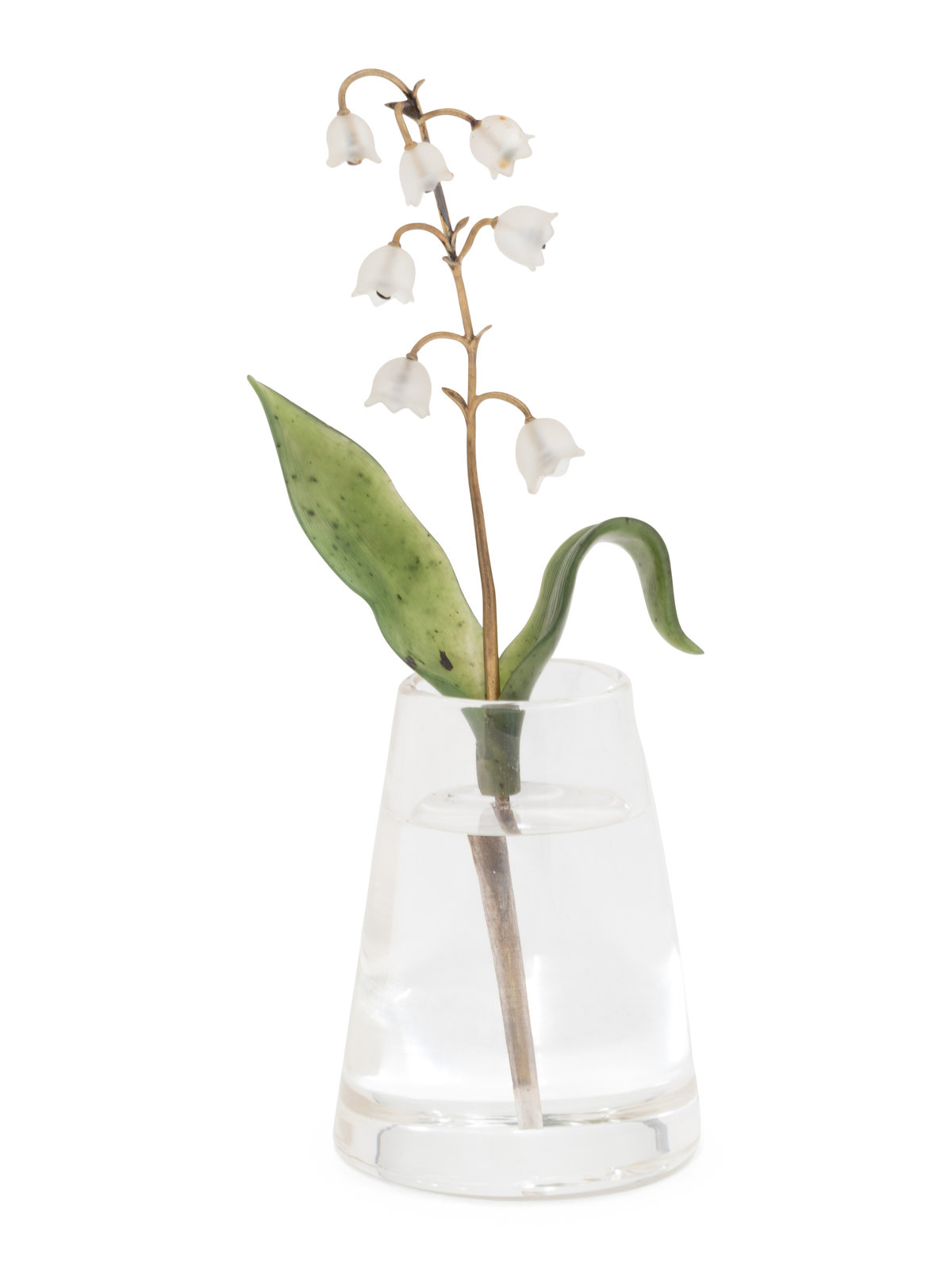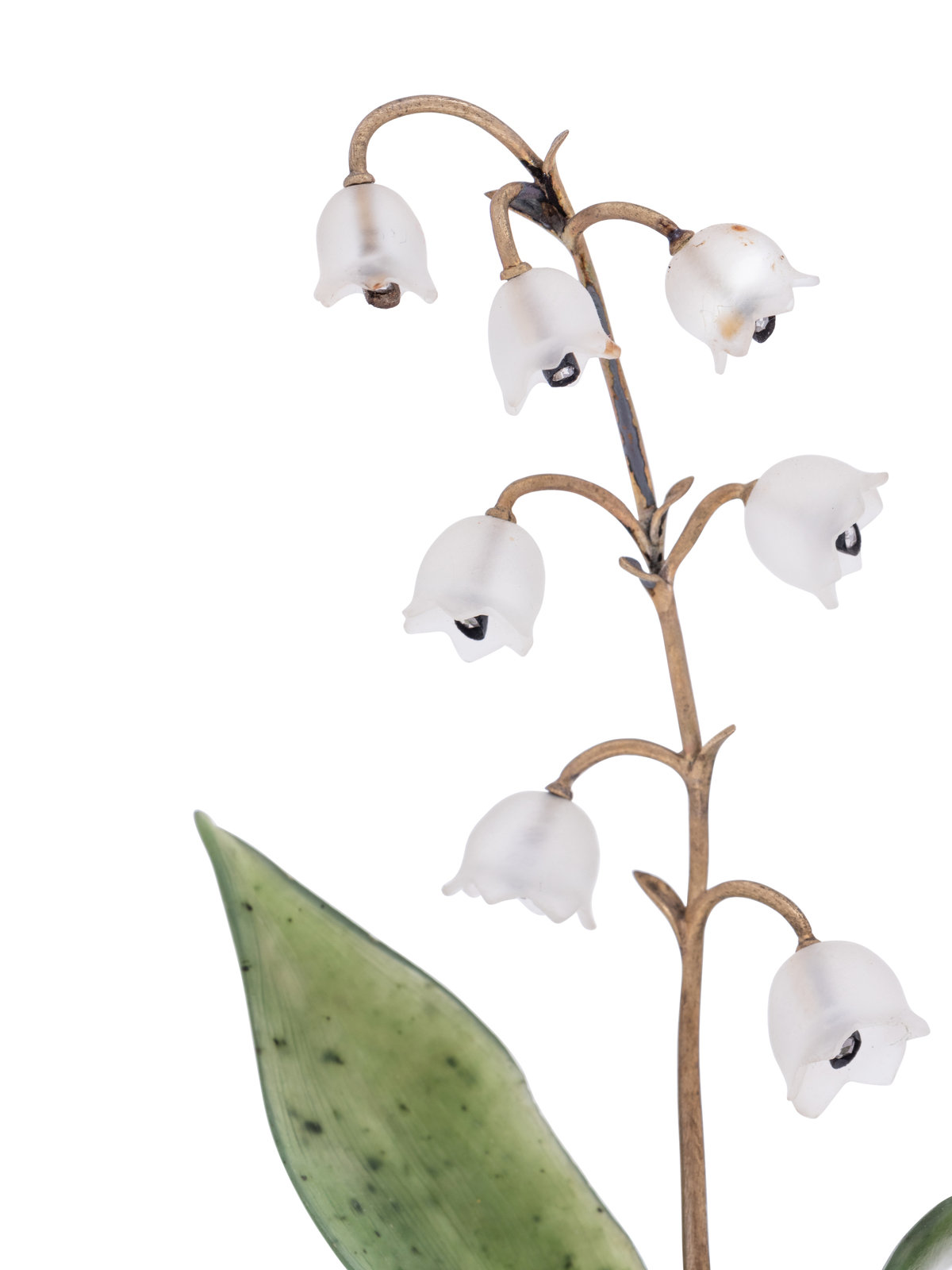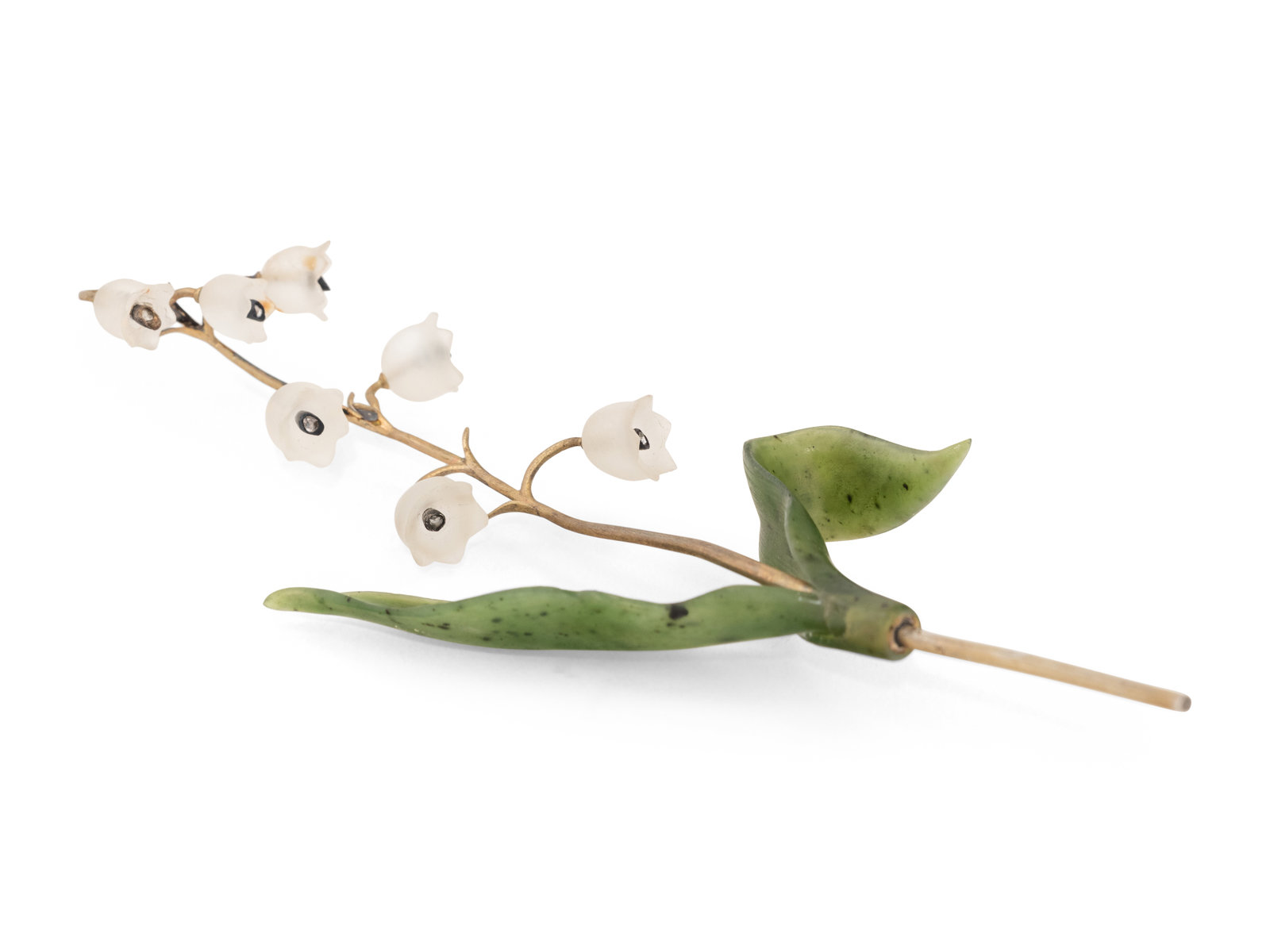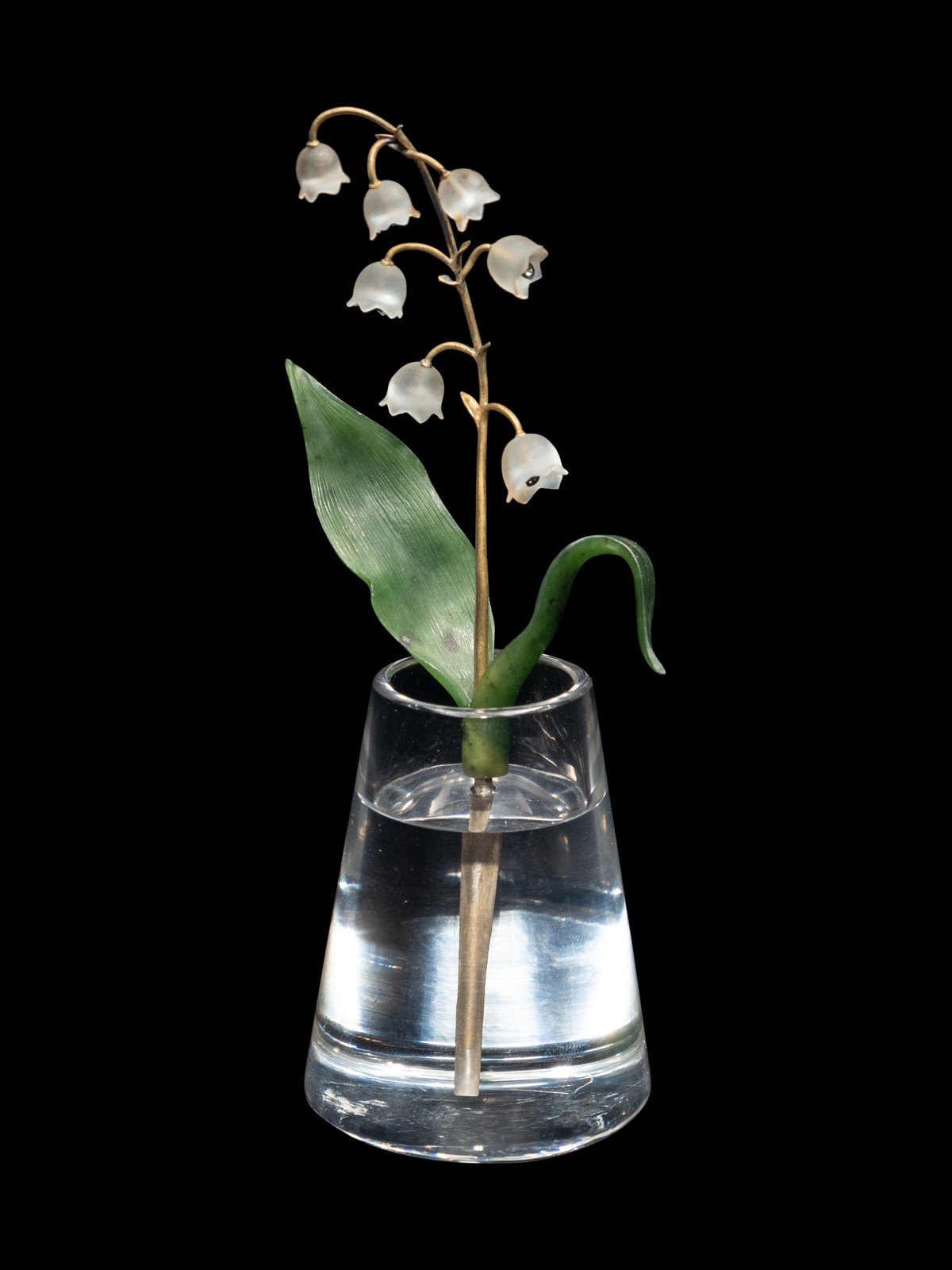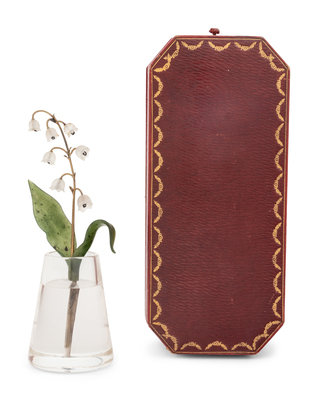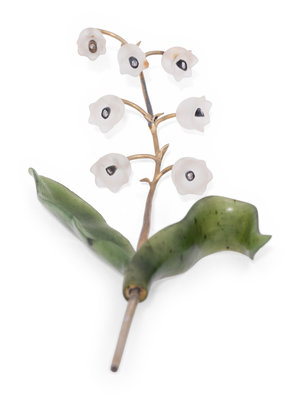An Important Cartier Carved Rock Crystal, Aventurine and Moonstone Lily of the Valley Flower Study
Sale 1157 - Property from the Fred and Kay Krehbiel Collection, Part I
Mar 15, 2023
10:00AM CT
Live / Chicago
Estimate
$10,000 -
$15,000
Sold for $63,000
Sold prices are inclusive of Buyer’s Premium
Lot Description
An Important Cartier Carved Rock Crystal, Aventurine and Moonstone Lily of the Valley Flower Study
Circa 1925
the stem with scratched inventory number '8614'.
Height 5 1/2 inches.
Height 5 1/2 inches.
This lot is located in Chicago.
Exhibited:
The Hermitage Museum, St. Petersburg, L'Art de Cartier, 14 May-20 June, 1992
Literature:
L'Art de Cartier, Exhibition Catalogue, p. 51 (with catalog)
Note:
As one of the first plants to emerge from the ice and cold of European winters, the delicate Lily of the Valley flower symbolizes renewal. This work by Cartier, dated to approximately 1925, embraces that symbolism while communicating the firm’s ascendence to the highest standards of craftsmanship following the closure of the House of Fabergé during the Russian Revolution. Using this motif, and probably employing the lapidary artisans that created Fabergé’s famous “flower studies” at the turn of the twentieth century [1], Cartier transmitted to the world that a French firm stood ready to assume the mantle of the world’s unmatched premiere jeweler.
Fabergé used the Lily of the Valley flower multiple times in works belonging to the Imperial family. First, on a large gold wire basket inset with a nephrite and pearl bouquet presented to Czarina Alexandra Feodorovna in 1896 (now housed in The Metropolitan Museum of Art, L.2011.66.56a, b), and two years later on an easter egg commissioned by Czar Nicholas II in 1898. While the name of the workmaster is typically the only name associated with them, Fabergé relied on the workshop of Carl Woerffel (and later Peter Kremlev) to work precious stones into the realistic leaves and flowers that adorn these objects. Woerffel’s workshop and the lapidarists they employed were not beholden to Fabergé as they also worked for other premiere European jewelers of the day [2]. A closer inspection of this flower study’s workmanship, particularly the carving of the parallel venules of the leaf, reveals distinct similarities and suggests a possible connection between the workshops of Woerffel and the lapidarist who made the present Cartier example.
Amongst the thousands of works produced by Fabergé, fewer than one hundred flower studies are known to exist. Much like this Cartier study, they are set within rock crystal bases and employ a multitude of materials and techniques, their luxurious construction only outdone by their verisimilitude. These works of art naturally found their way into Royal collections and the homes of titans of industry.
Cartier emerged from the 1920s as a premiere jeweler, proving that they could create works as technically and stylistically virtuosic as their now-defunct competitor. Like nature’s Lily of the Valley, Cartier sprang forth from the “winter” of the Russian Revolution and onto the global stage as a worthy successor to Fabergé.
[1] Gilles Chazal, L’Art de Cartier, Hermitage Museum, St. Petersburg, 1992, p. 49.
[2] Ulla Tillander-Godenheilm, Faberge: His Masters and Artisans, London, Unicorn Publishing Group, 2018, pp. 254-255.
Condition Report
In overall stable, attractive condition. The glass base with two small flat flakes to interior surrounding aperture for stem likely from contact to stem. One leaf with possible professional restoration where leaf meets stem. With fitted case. Additional images available upon request.
Condition reports are available upon request. All lots are sold “as is,” in the condition they are in at the time of the auction. The physical condition of lots can vary due to age, normal wear and tear, previous damage, and restoration. Prospective buyers are strongly advised to inspect a lot personally or through a knowledgeable representative prior to bidding. The absence of any reference to the condition of a lot does not imply that the lot is in perfect condition or completely free from wear and tear, imperfections, or the effects of aging. Prospective buyers must review and agree to the Conditions of Sale before participating in an auction, and it is the responsibility of the buyer to ensure that they have requested, received and considered any condition report.
Condition reports are available upon request. All lots are sold “as is,” in the condition they are in at the time of the auction. The physical condition of lots can vary due to age, normal wear and tear, previous damage, and restoration. Prospective buyers are strongly advised to inspect a lot personally or through a knowledgeable representative prior to bidding. The absence of any reference to the condition of a lot does not imply that the lot is in perfect condition or completely free from wear and tear, imperfections, or the effects of aging. Prospective buyers must review and agree to the Conditions of Sale before participating in an auction, and it is the responsibility of the buyer to ensure that they have requested, received and considered any condition report.
The physical condition of lots in our auctions can vary due to
age, normal wear and tear, previous damage, and
restoration/repair. All lots are sold "AS IS," in the condition
they are in at the time of the auction, and we and the seller make
no representation or warranty and assume no liability of any kind
as to a lot's condition. Any reference to condition in a catalogue
description or a condition report shall not amount to a full
accounting of condition. Condition reports prepared by Hindman
staff are provided as a convenience and may be requested from the
Department prior to bidding.
The absence of a posted condition report on the Hindman website or
in our catalogues should not be interpreted as commentary on an
item's condition. Prospective buyers are responsible for
inspecting a lot or sending their agent or conservator to inspect
the lot on their behalf, and for ensuring that they have
requested, received and understood any condition report provided
by Hindman.
Please email europeanfurniture@hindmanauctions.com for any additional information or questions you may have regarding this lot.
